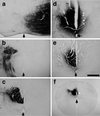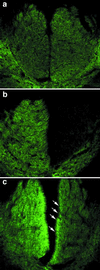Inosine stimulates extensive axon collateral growth in the rat corticospinal tract after injury
- PMID: 10557347
- PMCID: PMC23974
- DOI: 10.1073/pnas.96.23.13486
Inosine stimulates extensive axon collateral growth in the rat corticospinal tract after injury
Abstract
The purine nucleoside inosine has been shown to induce axon outgrowth from primary neurons in culture through a direct intracellular mechanism. For this study, we investigated the effects of inosine in vivo by examining whether it would stimulate axon growth after a unilateral transection of the corticospinal tract. Inosine applied with a minipump to the rat sensorimotor cortex stimulated intact pyramidal cells to undergo extensive sprouting of their axons into the denervated spinal cord white matter and adjacent neuropil. Axon growth was visualized by anterograde tracing with biotinylated dextran amine and by immunohistochemistry with antibodies to GAP-43. Thus, inosine, a naturally occurring metabolite without known side effects, might help to restore essential circuitry after injury to the central nervous system.
Figures





References
-
- Schnell L, Schwab M E. Nature (London) 1990;343:269–272. - PubMed
-
- McKerracher L, David S, Jackson D L, Kottis V, Dunn R J, Braun P E. Neuron. 1994;13:805–811. - PubMed
-
- Mukhopadhyay G, Doherty P, Walsh F S, Crocker P R, Filbin M T. Neuron. 1994;13:757–767. - PubMed
-
- Cheng H, Cao Y, Olson L. Science. 1996;273:510–513. - PubMed
Publication types
MeSH terms
Substances
Grants and funding
LinkOut - more resources
Full Text Sources
Other Literature Sources
Miscellaneous

